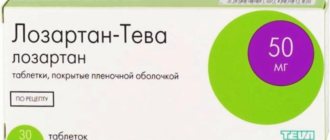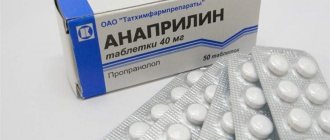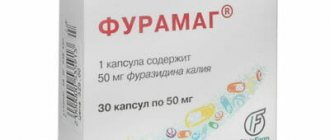Carbamazepine
Cytochrome P4503A4 (CYP 3A4) is the main enzyme responsible for the formation of carbamazepine-10,11-epoxide (the active metabolite). Concomitant use with a drug that is an inhibitor of the CYP3A4 isoenzyme may lead to increased plasma concentrations of carbamazepine, which, in turn, may cause adverse reactions. The simultaneous use of inducers of the CYP3A4 isoenzyme may lead to an acceleration of the metabolism of carbamazepine and, thus, to a possible decrease in its concentration in plasma and, consequently, to a possible decrease in the severity of the therapeutic effect of the drug. Cancellation of concomitantly taken inducers of the CYP3A4 isoenzyme may reduce the rate of biotransformation of carbamazepine, and, as a result, lead to an increase in the concentration of carbamazepine in the blood plasma.
Carbamazepine is a strong inducer of CYP3A4 and phase 1 and 2 hepatic enzyme systems and, when used concomitantly with drugs metabolized by CYP3A4, can cause induction of metabolism and a decrease in plasma concentrations.
Since the conversion of carbamazepine-10,11-epoxide to carbamazepine-10,11-transdiol occurs with the help of the microsomal enzyme epoxide hydrolase, the use of carbamazepine together with epoxide hydrolase inhibitors may lead to an increase in the plasma concentration of carbamazepine-10,11-epoxide.
Drugs that may increase plasma concentrations of carbamazepine:
dextropropoxyphene, ibuprofen, danazol, macrolide antibiotics (eg, erythromycin, troleandomycin, josamycin, clarithromycin); fluoxetine, fluvoxamine, nefazodone, paroxetine, trazodone, viloxazine, stiripentol, vigabatrin, azoles (eg, itraconazole, ketoconazole, fluconazole, voriconazole), loratadine, terfenadine, olanzapine, isoniazid, viral protease inhibitors for the treatment of HIV infection (eg, ritonavir ), acetazolamide, verapamil, diltiazem, omeprazole, oxybutynin, dantrolene, ticlopidine, nicotinamide (in adults, only in high doses), possibly cimetidine, desipramine.
Since an increase in the level of carbamazepine in the blood plasma can lead to adverse reactions (for example, dizziness, drowsiness, ataxia, diplopia), in these situations the dose of the drug should be adjusted and/or the concentration of carbamazepine in the blood plasma should be regularly determined.
Drugs that may increase plasma concentrations of carbamazepine 10,11-epoxide
: loxapine, quetiapine, primidone, progabide, valproic acid, valnoctamide and valpromide.
Since an increase in the level of carbamazepine-10,11-epoxide in the blood plasma can lead to adverse reactions (for example, dizziness, somnolence, ataxia, diplopia), in these situations the dose of Zeptol should be adjusted and/or the concentration of carbamazepine-10,11 should be regularly determined -epoxide in blood plasma.
Drugs that may reduce plasma concentrations of carbamazepine
: felbamate, methsuximide, oxcarbazepine, phenobarbital, phensuximide, phenytoin and fosphenytoin, primidone, theophylline, aminophylline, isotretinoin, rifampicin, cisplatin or doxorubicin, herbal preparations containing St. John's wort (Hypericum perforatum), and although the data are partly conflicting, possibly also clonazepam . When used simultaneously with the above drugs, it may be necessary; Carbamazepine dose adjustment.
Effect of carbamazepine on plasma concentrations of drugs used as concomitant therapy
When used together with carbamazepine, a decrease in plasma concentration, a decrease or even a complete cessation of the effect of some drugs is possible.
When used simultaneously with carbamazepine, dose adjustment of the following drugs may be required: methadone, paracetamol, phenazone (antipyrine), tramadol, doxycycline, oral anticoagulants (warfarin, phenprocoumon, dicumarol and acenocoumarol), bupropion, citalopram, trazodone, tricyclic antidepressants (imipramine, amitriptyline, nortriptyline, clomipramine), clobazam, clonazepam, ethosuximide, felbamate, lamotrigine, oxcarbazepine, primidone, tiagabine, topiramate, valproic acid, zonisamide, itraconazole, praziquantel, imatinib, clozapine, haloperidol, bromperidol, olanzapine, quetiapine, risperidone, ziprasidone, used for HIV therapies (indinavir, ritonavir, saquinavir), alprazolam, midazolam, theophylline, calcium channel blockers of the dihydropyridine group (for example, felodipine), digoxin, oral contraceptives (selection of alternative methods of contraception is necessary), glucocorticosteroids (for example, prednisolone, dexamethosone) , cyclosporine, everolimus; levothyroxine, drugs containing estrogens and/or progesterone.
There are reports that while taking carbamazepine, the level of phenytoin in the blood plasma may either increase or decrease, and the level of mephenytoin may increase (in rare cases).
Combinations to Consider
When carbamazepine was prescribed together with levetiracetam, an increase in the toxic effect of carbamazepine was observed in some cases.
There are reports of increased hepatotoxicity caused by isoniazid in cases where it was used concomitantly with carbamazepine.
The combined use of carbamazepine and lithium or metoclopramide, as well as carbamazepine and antipsychotic drugs (haloperidol, thioridazine) can lead to an increase in the frequency of adverse neurological reactions (in the case of the latter combination, even with therapeutic concentrations of active substances in the blood plasma.
The simultaneous use of carbamazepine with some diuretics (hydrochlorothiazide, furosemide) can lead to hyponatremia, accompanied by clinical manifestations.
Carbamazepine may antagonize the effects of non-depolarizing muscle relaxants (eg, pancuronium bromide). In the case of using such combinations of drugs, it may be necessary to increase the dose of these muscle relaxants; Patients should be closely monitored as the effects of muscle relaxants may cease more quickly than expected.
Bleeding has been reported in women between menstrual periods when oral contraceptives were used at the same time. The drug may reduce the therapeutic effect of oral contraceptives due to the induction of microsomal enzymes.
Carbamazepine, like other psychotropic drugs, can reduce alcohol tolerance. In this regard, the patient is advised to stop drinking alcohol.
Coadministration with grapefruit juice may increase plasma levels of carbamazepine.
Content:
- Action
- Application in addiction medicine
- Consequences
- How to avoid danger
Carbamazepine is a drug used for a range of mental disorders and neurological diseases. The need for long-term treatment with this drug explains the desire of patients to combine carbamazepine and alcohol, however, this can cause unpleasant and sometimes dangerous consequences.
How to avoid danger
The compatibility of alcohol and carbamazepine is a myth; ethanol should not be consumed during treatment. After the last dose of the drug, with long-term therapy you need to wait at least 24 hours, with a single use - at least 60 hours. If a person has drunk a half-liter bottle of vodka, the medication can be taken no earlier than a day later. In other cases, the time to start treatment is calculated using an alcohol calculator.
Carbamazepine therapy should be carried out in strict accordance with the doctor's recommendations. Taking a break to drink alcohol (for example, on the occasion of a holiday) can significantly affect the results. Therefore, you should be determined to continue abstinence for a long time. Can carbamazepine be taken with alcohol without danger to health? Absolutely not. This must be remembered throughout the entire period of treatment.
Action
Carbamazepine is a medicine from the group of sodium channel blockers. Affects nerve cells, blocks the transmission of impulses, slows down signal transmission. Reduces the level of norepinephrine and dopamine by suppressing the production of neurotransmitters.
Used for trigeminal neuralgia and other pain of neuropathic origin. Has an anticonvulsant effect. Effective for depression, bipolar affective disorder, agitation due to mania and hypomania, psychosis accompanied by behavioral disorganization. For alcoholism, it is used at the stage of development of withdrawal syndrome. Allows you to eliminate mental and neurological symptoms, reduce the likelihood of delirium tremens.
The half-life after a single dose reaches one and a half days or more, with regular use it decreases to 1 day. With a decrease in renal function, excretion slows down, the medication accumulates in the body, which necessitates the need to reduce the therapeutic dose.
Consequences
The combination of ethanol-containing drinks and carbamazepine is fraught with the following adverse effects:
- excessive excitement, nervousness, convulsive attacks are possible;
- the body's resistance decreases, ethanol becomes more toxic and can cause severe intoxication or poisoning even when taking small doses;
- the likelihood of damage to internal organs under the influence of toxic compounds increases (kidneys, liver, heart, pancreas suffer);
- there is a risk of developing neurological and mental disorders: gait disturbances, delirium, hallucinations, increased aggressiveness, depression, and sometimes psychotic episodes.
Emergency conditions that require immediate medical attention and can be fatal include a sharp increase in blood pressure (including with the development of strokes and transient cerebrovascular accidents), pulmonary edema and cardiac arrest. Long-term consequences of carbamazepine and alcohol, especially likely with constant joint use, are changes in hormonal levels and impotence.
Alcohol makes the side effects of the medication worse. The risk of allergic reactions, nausea and vomiting, fluid retention, swelling, shortness of breath, headaches, memory and speech disorders increases. Changes in the hematopoietic system (decrease in the number of red blood cells, platelets and leukocytes) with symptoms of anemia, decreased immunity and bleeding cannot be excluded. Some patients experience increased intraocular pressure and clouding of the lens. Dangerous complications from internal organs are hepatitis and pancreatitis.
The combination of drugs and alcohol is always fraught with unpredictable effects. It is impossible to predict in advance how the body will react to such an impact and how severe the consequences will be. The only way to prevent the threat is to remember that simultaneous use is inadmissible and take precautions.









